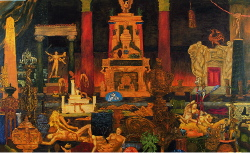J P Munro
Sadie Coles HQ, London, UK
Sadie Coles HQ, London, UK

The storeroom in JP Munro's painting Ending is Better than Mending (2002) looks like somewhere mythologies go to die. Clusters of urns, statues and an obelisk fill the foreground. Dead bodies - curiously beige, with haircuts similar to James Spader's circa Pretty in Pink (1986) - slump among the artefacts, spears sticking out of their stomachs. In the centre of the room, at the base of a big, bad-taste altar, a tiny white-walled town is trapped in a bubble of blue pigment. This town appears again on the painting's left, peeking through a heavy curtain. It's up on a hill, a long way away. The skies surrounding it swarm with stars.
Everything about Ending is Better than Mending is ambitious. Scale-wise it's a whopper, and its pile-up of mythological and quasi-mythological reference points - statues of Athena and Shiva, the Symbolist painter Gustave Moreau - suggests the same hubris that blighted J. G. Frazer's The Golden Bough (1890) and Joseph Campbell's The Hero with a Thousand Faces (1949), two attempts to map mankind's cosmological common ground. Munro's painting isn't so intellectually lazy (he's no sloppy Structuralist), although there's something slack about his brushwork. Given the art-historical giants he samples - Jacques-Louis David, Eugène Delacroix and Jean-Auguste-Dominique Ingres are all in the mix - this is a matter less of mediocrity than of successful simulation. Look, really look, at most pre-Modern masterpieces and you'll discover - in the drapery, perhaps, or on the horse's hind legs - a passage of bad, bargain-basement painting. Munro amplifies these failures. In Ending is Better than Mending competently painted pillars share space with slipshod swags, and the pasty, fallen bodies have clumsily foreshortened limbs. Such unevenness is unusual in 20th-century art (the all-overness of, say, De Kooning simply doesn't allow it). Maybe Munro makes use of this device to defuse his forebears, or to dodge the charge that he's a reheated Classicist in the mould of Stephen McKenna. Whatever the reason, it makes his canvases compelling - it's hard not to get snagged on their hit-and-miss surfaces.
Back to that white-walled city, trapped in a teardrop. It resembles something from a story by Jorges Luis Borges, or a kitschy snowstorm that's failed to function. In a painting so steeped in well-worn iconography (griffins, golden eagles, Atlas staggering under the weight of the world) it seems strange, inscrutable. Perhaps it's the property of the dead men dotted among the statues, but if so, who are they, and why have they come to collect it? Are they citizens of the city on the hill? Is the miniature metropolis the city's soul, stolen by some crazed collector? Maybe we're not meant to 'get' its meaning, and it's just a sad, semi-musical note - nothing more. Start to think about Munro's mythological bits and bobs in a similar manner and his paintings become brilliant comments on image-making, on how shapes and shades suggest complex, culturally loaded stuff. Ending is Better than Mending isn't a Claude Lévi-Strauss-like search for an Ur-mythology. Rather, it's an attempt to grapple with what painting can do.
Munro's drawing Untitled (2002) is a study of one of the statues in Ending is Better than Mending, a many-armed deity with a Clint Eastwood countenance and a long, dangling dick. Beneath this brutal god Munro has pencilled, and then partially erased, the words 'Hellenistic Shiva'. On top of these the words 'Abraxas, Angel of Death' appear. Abraxas is a minor mythological figure (my Oxford Companion to Classical Literature from 1964 makes no mention of him), who enjoyed a revival at the hands of the same hippy counterculture that attempted to rehabilitate the swastika. Perhaps that's why - with his perfect, pumped-up body - he'd feel at home striding through The Occult Roots of Nazism (2002), a Teutonic landscape cribbed from Caspar David Friedrich. Equating National Socialism with 19th-century Romanticism feels both bogus and wearyingly over-familiar, but there's something about Munro's bone-dry brushwork that sums up the poverty - and the aridity - of the Nazi mindset. Technically, it's the worst work in the show, but somehow you wouldn't want it any other way.
For all his high-minded meditations on art history Munro sometimes seems like he's having an awful lot of fun. Another painting called Ending is Better than Mending (2001) (Munro repeats his titles like stuck records or thoughts you can't shake off) is a case in point. A battle scene - loosely based on a David painting - is a jumble of lethal limbs. Above the action fly four beautifully painted parrots. They are absurd, but so is art, and so is its history. Munro knows this, and that's what makes his paintings tick.

























